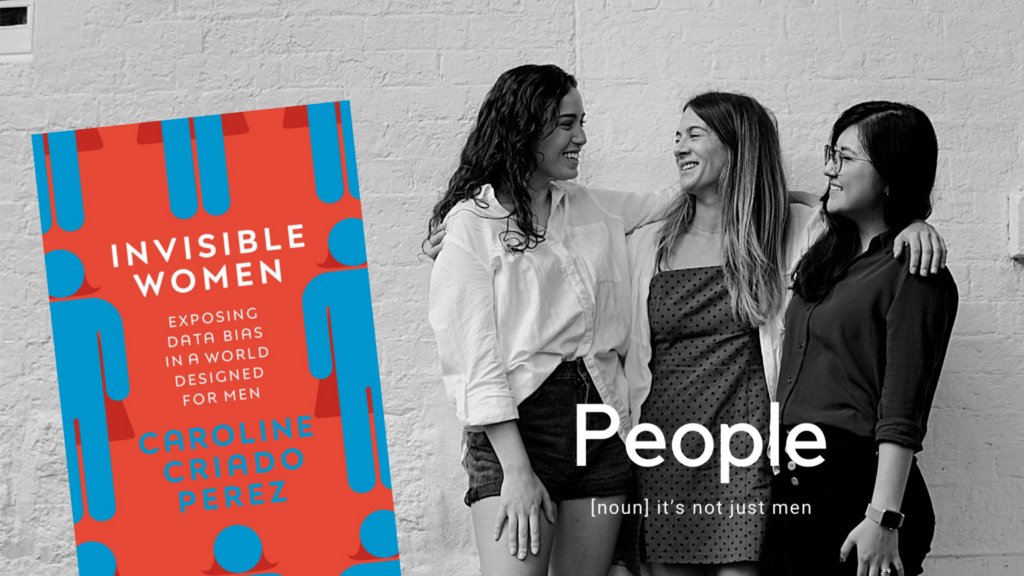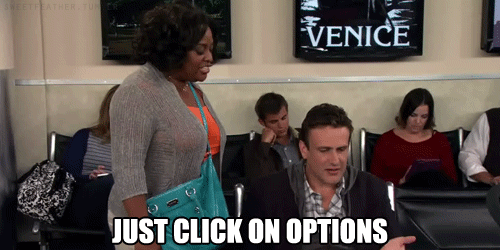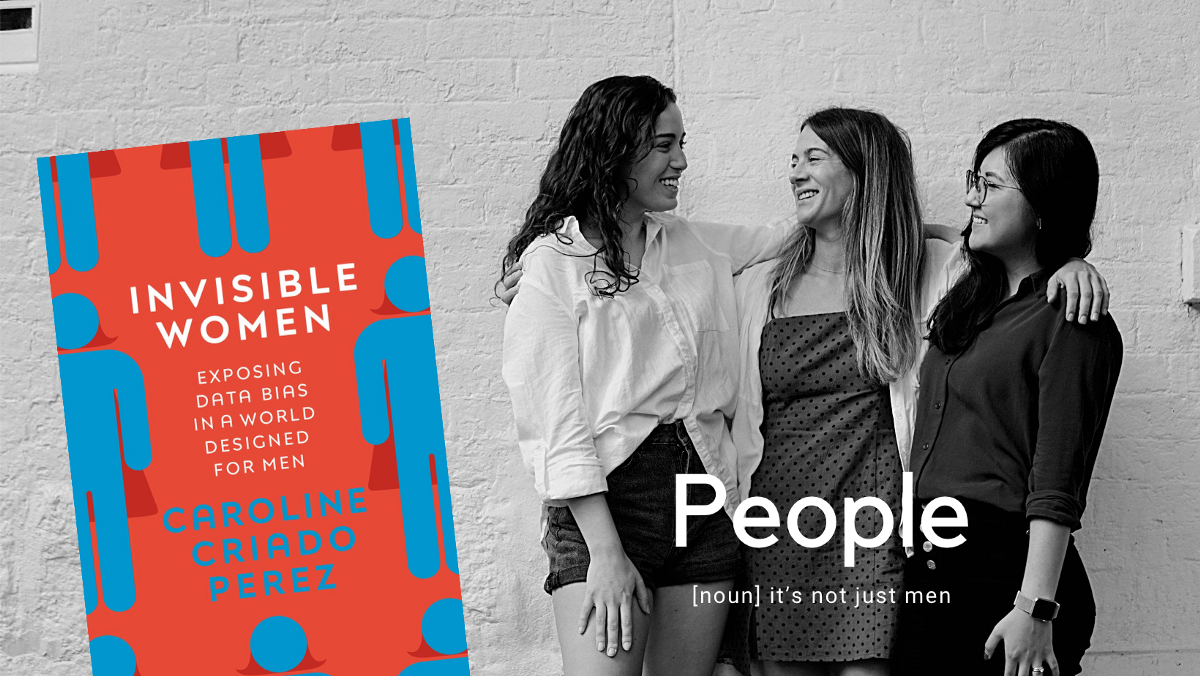Over a year ago, my ex-boss sent me a screenshot of a book cover on Telegram. I just knew I have to read it. I know I am not supposed to judge the book by its cover but I did. Not because the cover is particularly spectacular but because the title is so captivating. So as you may have guessed, it is “Invisible Women: Data Bias in a World Designed for Men” by Caroline Criado Perez. I was starting to get into data-informed design, trying to incorporating data into my design making process.
So, the book couldn’t arrive in my iBooks shelf at a better time. Of course, the book title doesn’t disappoint, I quickly found out from the very first chapter that majority of the data that exists, and that I was hoping to based my decisions on are biased, or rather just don’t have women’s data in them. I am saying from no data science background, but isn’t all this super ironic? We use data to inform our decision because data is factual; unlike opinions or perspectives, but the data fails half of the population, female, me, and you.

I have recently given a presentation on what is UX Design and I had a lot of fun discussing what is a bad UX and what is good. I brought up an example on how bad design is affecting women — an example I read from the book. And the small audience found it fascinating and everyone agrees that these bad designs are very obvious but at the same time we didn’t talk about this; we didn’t think that someone obviously has thought about designing the bathrooms the way they are, which is not necessarily fair for women (keep reading to learn what how unfair bathrooms are for women). So, I thought I would write about what I learnt from the book and how relevant it is to our daily life and my profession as a designer. I also hope that my typical girl’s voice, light-weight-data-more-stories approach to the book can be resonating to everyone, males and females. Hopefully, this International Women Day and many more to go, everyone start to look around and really point out a gender-blind design.

Human is male unless stated otherwise
The data we have, as argued by the book is based on men: their behavior, their physiques, and their biology. If the data says men, as in human beings (even the language is so biased), what they are mainly referring to is male beings’ data. Men become the default people, even though we know that women and men are so different. Omitting women from the data means we are making decisions, designing spaces and systems without considering the other half of the population. Male is the default, and therefore as females, we have to get creative navigating the world that is not designed for us.
Equal square meters is not equal
This was the example I pointed out during my UX presentation. As women, we are used to wait in queue for public toilets. Airports, cinemas, you name it, we know there is going to be a queue at the female toilets, while the male side seems to have no such issue. This is what gender-blind design looks like. The architects are very fair, they design the male and female toilets to occupy the same square meters. Everyone is equal. Not really.
What they fail to consider, even though their hearts may be in the right place, is the fact that women need more space and more time in the restrooms. Women need to change pads or tampons during periods. Women often have children or seniors to tend to at the bathrooms. And biologically, we need more frequent trips to the bathrooms because of pregnancy and the likelihood of urinal-related infections. So, how is that equal really?

Technology is designed for men
I work in Tech, and I am always proud to be one of the few women in tech. However, perhaps because of lack of women representatives in the field that we are not seeing any major innovation that are actually solving women’s problems, and worse, we are just witnessing innovations that are gender-blind, really they were designed for the default males only.
I used to wonder how these health apps on my phone would be able to measure how many steps I walk in a day when I don’t have the phone with me. Naive, yeah I know. The answer is they don’t. These apps are designed for those who have their phones in their pant pockets at all time. And spoiler, women don’t have pockets. Of course, now we have all these wearables that are supposed to solve this issue, right? Males and females can wear them. Well, despite the fact that some of these watches are too big for the average female wrists, they are also not designed to measure the activities that women do. Caroline, the author pointed how that they tend to discounts the labour or the steps taken during housework by up to 70%.
https://medium.com/media/c485d53a4aeb319ff3da8da9cf248f98/href
This gender-blind, male-default design also extends to the common exercise equipment, Treadmills. This was very surprising for me to read because how can such an old invention still so biased. The calculation on treadmills are defaulted to the reference male’s weight. To be fair, you can adjust the weight, just find the “Settings”. However, once you do that, the calculation is still inaccurate. The design still fails to take into account the fact that women “have a higher fat and lower muscle distribution and different ratios of various muscle fibers”. Treadmills fail us so hard😢.

Hey Google, what about the safest way home?
Google Maps is one of the most frequent apps I use, to get away from a huge traffic jam or when my brain is too occupied that I got lost on my way to work. While it offers a lot of great features and the ability to get me back on track and get me to my location faster, there is no suggested safest route I can take, a well-lit crowded community that make me feel safer. And that is important for anyone, but especially important for women. We are more likely to be harassed during these commutes, especially if taken public transports.
Now, I have done my quick google search and found out that Google has developed a feature “Stay Safer” aiming to alert users if the driver go-off Google’s suggested routes. It also allows users to share live location with close ones as well. This however still hasn’t addressed whether the suggested routes are safe in the first place. However, I am still pretty optimistic that they are looking into it.
How about Grab and other ride-hailing apps? While Grab offers this suggested route, which is not necessarily the safest or the fastest, mainly just their way of calculating how much it cost, the drivers don’t necessary follow the route. As a woman, ridding Grab and similar transportations is very risky. You see rape and murder cases very often on the news. I would often have to instruct the driver what road to take and that I would pay extra if he follows. Thankfully, the drivers followed my instructions, and thankfully I know what the safest routes are. There is no mechanism within the app to help make me safe riding at night. There are of course other safety features within the app, but it is not enough. Shouldn’t safety route be a priority for a safety feature?
Designed to protect the male bodies
In the book, the author also pointed out how car design and safety tests are designed with a male-default mindset. For instance, the car seats are generally “too firm to protect women against whiplash injuries: the seats throw women forward faster than men because of the back of the seat doesn’t give way for women’s on average lighter bodies.” This is because the car-crash test dummies are based on the average male, not taken into account the differences between male and female bodies. These dummies of course are not designed to resemble pregnant women in anyways, not for driver or passenger seats. Even though it is recommended that pregnant women should wear seatbelts, more than half of “third-trimester pregnant women don’t fit the standard seat-belt design.”

Unintentional is the problem
All these examples mentioned above maybe done unintentionally. The products, the space and systems are designed to help people and make lives easier. But without consideration of the difference between male and female, we are doing the male-default, leaving out more than 50% of the population. As a designer myself, I am very much guilty of being ignorant about all these until the book pointed out. This gender-blind design is so obvious and yet all I had been doing is following the design trends which are already biased.
“Designers may believe they are making products for everyone, but in reality they are making them for men. It’s time to start designing women in”, wrote Caroline Criado Perez.
The Excuses
This article in many ways doesn’t do the book justice. Caroline was able to clearly, using data and daily examples to illustrate how big of data gap we have and how this is causing gender-blind in the way we are designing the world. Some of the examples I mentioned may not be vital but when doctors only study and talk about the male anatomy, this leaves many of health symptoms faced by female becomes atypical, because again the male version is typical. And that is life-threatening.
It is a fact that female bodies are complicated and again so different from the typical default male. But this is more of the reason to better study female’s behavior and bodies rather than leaving us out. The excuses go like this:
“Female bodies are too unharmonious, too menstrual and too hormonal. Women’s travel patterns are too messy, their work schedules are too aberrant, their voices are too high”, the author wrote.
https://medium.com/media/f968eea6f785ae0101b409156f931f96/href
It takes a woman in power to correct the flaw in the default-male design
Again, male-default is a habit for all of us, women included. We are living in a world designed for men, so we become used to and blind to all these bad design. While it takes women to notice the flaws in these bad design, it takes women in power to correct the flaws. One of the example, Caroline, the author mentioned is what happen with Sheryl Sandberg, now COO of Facebook. She was at Google then. While pregnant, she felt frustrated with how long she had to walk to and from the car park of the Google building. With her body changed, it was impossible to walk that far. She brought the issues up to the Google co-founders and they were surprised they didn’t notice such a huge flaw. Of course, neither did Sheryl Sandberg before her pregnancy. The car park was designed carefully but again without thinking about the women bodies. It takes an important person like Sheryl to voice out the concern that many other female employees have.

Women raise each other up
There is no doubt that there is a strong correlation between the lack of women in leadership positions and the female data gaps. It is impossible for men to notice this flaw and understand how this is impacting women when there are no existing data to base their decision on. Like Sheryl Sandberg example above, it takes a woman to notice how poorly the parking space is designed. We need more women to involve in these decision making to close the gender gap and to be inclusive. And it is proven that when women are in influential positions, we raise each other up. Women are more likely to give opportunities to women.
“The solution to the sex and gender data gap is clear: we have to close the female representation gap. When women are involved in decision-making, in research, in knowledge production, women do not get forgotten”.
https://medium.com/media/d456779b89ccba2c15ec057d721de4ae/href
While this is not a book review, I really urge you read “Invisible Women: Data Bias in a World Designed for Men” by Caroline Criado Perez, and hopefully from now on, we start noticing all these gaps in the design of the world we live in. If book is not something you enjoyed, these are some films I recommend:
And my favorite podcast for young female professionals from HBR:
I hope this article brings awareness to the male-default world we are living in. Again, it is of no fault of any males whose hearts are in the right place. We just simply need a new perspective and more women involved in how we design the world.
Happy international women day. Let’s choose to challenge all these gender-blind design together!

Invisible women: When you only design for 50% of the population was originally published in UX Collective on Medium, where people are continuing the conversation by highlighting and responding to this story.
